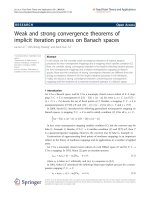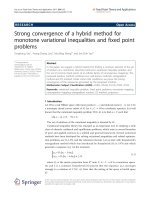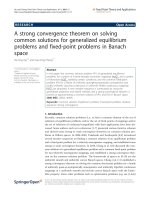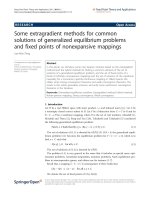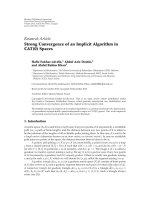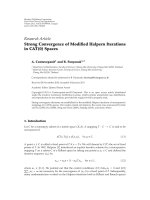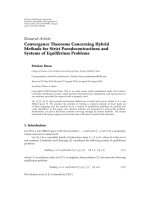Weak and strong convergence of subgradient extragradient methods for pseudomonotone equilibrium problems
Bạn đang xem bản rút gọn của tài liệu. Xem và tải ngay bản đầy đủ của tài liệu tại đây (345.82 KB, 14 trang )
Wen Fixed Point Theory and Applications 2014, 2014:232
/>
RESEARCH
Open Access
Weak and strong convergence of hybrid
subgradient method for pseudomonotone
equilibrium problem and multivalued
nonexpansive mappings
Dao-Jun Wen*
*
Correspondence:
College of Mathematics and
Statistics, Chongqing Technology
and Business University, Chongqing,
400067, China
Abstract
In this paper, we introduce a hybrid subgradient method for finding a common
element of the set of solutions of a class of pseudomonotone equilibrium problems
and the set of fixed points of a finite family of multivalued nonexpansive mappings in
Hilbert space. The proposed method involves only one projection rather than two as
in the existing extragradient method and the inexact subgradient method for an
equilibrium problem. We establish some weak and strong convergence theorems of
the sequences generated by our iterative method under some suitable conditions.
Moreover, a numerical example is given to illustrate our algorithm and our results.
MSC: 47H05; 47H09; 47H10
Keywords: pseudomonotone equilibrium problem; multivalued nonexpansive
mapping; hybrid subgradient method; fixed point; weak and strong convergence
1 Introduction
Let H be a real Hilbert space with inner product ·, · and norm · , respectively. Let
K be a nonempty closed convex subset of H. Let F : K × K → R be a bifunction, where
R denotes the set of real numbers. We consider the following equilibrium problem: Find
x ∈ K such that
F(x, y) ≥ ,
∀y ∈ K.
(.)
The set of solution of equilibrium problem is denoted by EP(F, K). It is well known that
some important problems such as convex programs, variational inequalities, fixed point
problems, minimax problems, and Nash equilibrium problem in noncooperative games
and others can be reduced to finding a solution of the equilibrium problem (.); see [–]
and the references therein.
Recall that a mapping T : K → K is said to be nonexpansive if
Tx – Ty ≤ x – y ,
∀x, y ∈ K.
A subset K ⊂ H is called proximal if for each x ∈ H, there exists an element y ∈ K such that
dist(x, K) := x – y = inf x – z : z ∈ K .
©2014 Wen; licensee Springer. This is an Open Access article distributed under the terms of the Creative Commons Attribution License ( which permits unrestricted use, distribution, and reproduction in any
medium, provided the original work is properly cited.
Wen Fixed Point Theory and Applications 2014, 2014:232
/>
Page 2 of 14
We denote by B(K), C(K), and P(K) the collection of all nonempty closed bounded subsets,
nonempty compact subsets and nonempty proximal bounded subsets of K , respectively.
The Hausdorff metric H on B(H) is defined by
H(K , K ) := max sup dist(x, K ), sup dist(y, K ) ,
x∈K
∀K , K ∈ B(H).
y∈K
Let T : H → H be a multivalued mapping, of which the set of fixed points is denoted
by Fix(T), i.e., Fix(T) := {x ∈ Tx : x ∈ K}. A multivalued mapping T : K → B(K) is said to
be nonexpansive if
H(Tx, Ty) ≤ x – y ,
∀x, y ∈ K.
(.)
T is said to be quasi-nonexpansive if, for all p ∈ Fix(T),
H(Tx, p) ≤ x – p ,
∀x ∈ K.
(.)
Recently, the problem of finding a common element of the set of solutions of equilibrium problems and the set of fixed points of nonlinear mappings has become an attractive
subject, and various methods have been extensively investigated by many authors. It is
worth mentioning that almost all the existing algorithms for this problem are based on
the proximal point method applied to the equilibrium problem combining with a Mann
iteration to fixed point problems of nonexpansive mappings, of which the convergence
analysis has been considered if the bifunction F is monotone. This is because the proximal
point method is not valid when the underlying operator F is pseudomonotone. Another
basic idea for solving equilibrium problems is the projection method. However, Facchinei
and Pang [] show that the projection method is not convergent for monotone inequality, which is a special case of monotone equilibrium problems. In order to obtain convergence of the projection method for equilibrium problems, Tran et al. [] introduced
an extragradient method for pseudomonotone equilibrium problems, which is computationally expensive because of the two projections defined onto the constrained set. Efforts
for deducing the computational costs in computing the projection have been made by using penalty function methods or relaxing the constrained convex set by polyhedral convex
ones; see, e.g., [–].
In , Santos and Scheimberg [] further proposed an inexact subgradient algorithm
for solving a wide class of equilibrium problems that requires only one projection rather
than two as in the extragradient method, and of which computational results show the
efficiency of this algorithm in finite dimensional Euclidean spaces. On the other hand, iterative schemes for multivalued nonexpansive mappings are far less developed than those
for nonexpansive mappings though they have more powerful applications in solving optimization problems; see, e.g., [–] and the references therein.
In , Eslamian [] considered a proximal point method for nonspreading mappings
and multivalued nonexpansive mappings and equilibrium problems. To be more precise,
they proposed the following iterative method:
F(un , z) + rn y – un , un – xn ≥ , ∀y ∈ K,
xn+ = αn un + βn fn un + γn zn , n ≥ ,
(.)
Wen Fixed Point Theory and Applications 2014, 2014:232
/>
Page 3 of 14
where Tn = Tn(mod N) , zn ∈ Tn un , αn + βn + γn = for all n ≥ and fi , Ti are finite families
of nonspreading mappings and multivalued nonexpansive mappings for i = , , . . . , N , respectively. Moreover, he further proved the weak and strong convergence theorems of the
iterative sequences under the condition of monotone defined on a bifunction F.
In this paper, inspired and motivated by research going on in this area, we introduce
a hybrid subgradient method for the pseudomonotone equilibrium problem and a finite
family of multivalued nonexpansive mappings, which is defined in the following way:
⎧
⎪
⎨ wn ∈ ∂ n F(xn , ·)xn ,
un = PK (xn – γn wn ), γn = max{σβnn, wn } ,
⎪
⎩
xn+ = αn xn + ( – αn )zn , n ≥ ,
(.)
where Tn = Tn(mod N) , zn ∈ Tn un , and {αn }, {βn }, { n }, and {σn } are nonnegative real sequences.
Our purpose is not only to modify the proximal point iterative schemes (.) for the
equilibrium problem to a hybrid subgradient method for a class of pseudomonotone equilibrium problems and a finite family of multivalued nonexpansive mappings, but also to
establish weak and strong convergence theorems involving only one projection rather than
two as in the extragradient method [] and the inexact subgradient method [] for the
equilibrium problem. Our theorems presented in this paper improve and extend the corresponding results of [, , , ].
2 Preliminaries
Let K be a nonempty closed convex subset of a real Hilbert space H with inner product
·, · and norm · , respectively. For every point x ∈ H, there exists a unique nearest point
in K , denoted by PK (x), such that
x – PK (x) ≤ x – y ,
∀y ∈ K.
Then PK is called the metric projection of H onto K . It is well known that PK is nonexpansive and satisfies the following properties:
x – PK (x), PK (x) – y ≥ ,
x–y
≥ x – PK (x)
∀x ∈ H, y ∈ K,
+ y – PK (x) ,
(.)
∀x ∈ H, y ∈ K.
(.)
Recall also that a bifunction F : K × K → R is said to be
(i) r-strongly monotone if there exists a number r > such that
F(x, y) + F(y, x) ≤ –r x – y ,
∀x, y ∈ K;
(ii) monotone on K if
F(x, y) + F(y, x) ≤ ,
∀x, y ∈ K;
(iii) pseudomonotone on K with respect to x ∈ K if
F(x, y) ≥
⇒
F(y, x) ≤ ,
∀y ∈ K.
(.)
Wen Fixed Point Theory and Applications 2014, 2014:232
/>
Page 4 of 14
It is clear that (i) ⇒ (ii) ⇒ (iii), for every x ∈ K . Moreover, F is said to be pseudomonotone
on K with respect to A ⊆ K , if it is pseudomonotone on K with respect to every x ∈ A.
When A ≡ K , F is called pseudomonotone on K .
The following example, taken from [], shows that a bifunction may not be pseudomonotone on K , but yet is pseudomonotone on K with respect to the solution set of
the equilibrium problem defined by F and K :
∀x, y ∈ R,
F(x, y) := y|x|(y – x) + xy|y – x|,
K := [–, ].
Clearly, EP(F, K) = {}. Since F(y, ) = for every y ∈ K , this bifunction is pseudomonotone on K with respect to the solution x∗ = . However, F is not pseudomonotone on K .
In fact, both F(–., .) = . > and F(., –.) = . > .
To study the equilibrium problem (.), we may assume that is an open convex set
containing K and the bifunction F : × → R satisfy the following assumptions:
(C) F(x, x) = for each x ∈ K and F(x, ·) is convex and lower semicontinuous on K ;
(C) F(·, y) is weakly upper semicontinuous for each y ∈ K on the open set ;
(C) F is pseudomonotone on K with respect to EP(F, K) and satisfies the strict
paramonotonicity property, i.e., F(y, x) = for x ∈ EP(F, K) and y ∈ K implies
y ∈ EP(F, K);
(C) if {xn } ⊆ K is bounded and n → as n → ∞, then the sequence {wn } with
wn ∈ ∂ n F(xn , ·)xn is bounded, where ∂ F(x, ·)x stands for the -subdifferential of
the convex function F(x, ·) at x.
Throughout this paper, weak and strong convergence of a sequence {xn } in H to x are
denoted by xn
x and xn → x, respectively. In order to prove our main results, we need
the following lemmas.
Lemma . [] Let H be a real Hilbert space. For all x, y ∈ H, we have the following identity:
x–y
= x
– y
– x – y, y .
Lemma . [] Let H be a real Hilbert space and α, β, γ ∈ [, ] with α + β + γ = . For
all x, y, z ∈ H, we have the following identity:
αx + βy + γ z
=α x
+β y
– αγ x – z
+γ z
– αβ x – y
– βγ y – z .
Lemma . [] Let {an } and {bn } be two sequences of nonnegative real numbers such that
an+ ≤ an + bn ,
where
∞
n= bn
n ≥ ,
< ∞. Then the sequence {an } is convergent.
Lemma . [] Let K be a nonempty closed convex subset of a real Hilbert space H. Let T :
q and limn→∞ dist(xn , Txn ) =
K → C(K) be a multivalued nonexpansive mapping. If xn
, then q ∈ Tq.
Wen Fixed Point Theory and Applications 2014, 2014:232
/>
Page 5 of 14
3 Weak convergence
Theorem . Let K be a nonempty closed convex subset of a Hilbert space H and F : K ×
K → R be a bifunction satisfying (C)-(C). Let {Ti }N
i= : K → C(K) be a finite family of
multivalued nonexpansive mappings such that = N
i= Fix(Ti ) ∩ EP(F, K) = φ and Ti (q) =
{q} for i = , , . . . , N and q ∈ . For a given point x ∈ K , < c < σn < σ , {αn }, {βn }, and { n }
are nonnegative sequences satisfying the following conditions:
(i) αn ∈ [a, b] ⊂ (, );
∞
∞
∞
(ii)
n= βn = ∞,
n= βn < ∞, and
n= βn n < ∞.
Then the sequence {xn } generated by (.) converges weakly to x ∈ .
Proof First, we show the existence of limn→∞ xn – p for every p ∈ . It follows from (.)
and Lemmas . and . that
xn+ – p
= αn (xn – p) + ( – αn )(zn – p)
= αn xn – p
+ ( – αn ) zn – p
= αn xn – p
+ ( – αn ) dist(zn , Tn p) – αn ( – αn ) xn – zn
≤ αn xn – p
+ ( – αn )H(Tn un , Tn p) – αn ( – αn ) xn – zn
≤ αn xn – p
+ ( – αn ) un – p
= αn xn – p
+ ( – αn ) xn – p
– αn ( – αn ) xn – zn
≤ xn – p
– αn ( – αn ) xn – zn
– αn ( – αn ) xn – zn
– un – xn
+ xn – un , p – un
+ ( – αn ) xn – un , p – un – αn ( – αn ) xn – zn .
(.)
By un = PK (xn – γn wn ) and (.), we have
xn – un , p – un ≤ γn wn , p – un .
(.)
Using un = PK (xn – γn wn ) and xn ∈ K again, we obtain (note that γn =
xn – un
βn
)
max{σn , wn }
= xn – un , xn – un
≤ γn wn , xn – un
≤ γn wn
xn – un
≤ βn xn – un ,
(.)
which implies that xn – un ≤ βn . Substituting (.) into (.) yields
xn+ – p
≤ xn – p
+ ( – αn )γn wn , p – un – αn ( – αn ) xn – zn
= xn – p
+ ( – αn )γn wn , p – xn + ( – αn )γn wn , xn – un
– αn ( – αn ) xn – zn
≤ xn – p
+ ( – αn )γn wn , p – xn + ( – αn )γn wn
– αn ( – αn ) xn – zn
xn – un
Wen Fixed Point Theory and Applications 2014, 2014:232
/>
≤ xn – p
Page 6 of 14
+ ( – αn )γn wn , p – xn + ( – αn )βn
– αn ( – αn ) xn – zn .
(.)
Since wn ∈ ∂ n F(xn , ·)xn and F(x, x) = for all x ∈ K , we have
wn , p – xn ≤ F(xn , p) – F(xn , xn ) +
≤ F(xn , p) +
n
n.
(.)
On the other hand, since p ∈ EP(F, K), i.e., F(p, x) ≥ for all x ∈ K , by the pseudomonotonicity of F with respect to p, we have F(x, p) ≤ for all x ∈ K . Replacing x by xn ∈ K , we
get F(xn , p) ≤ . Then from (.) and (.), it follows that
xn+ – p
≤ xn – p
+ ( – αn )γn F(xn , p) + ( – αn )γn
– αn ( – αn ) xn – zn
n
+ ( – αn )βn
≤ xn – p
+ ( – αn )γn
n
+ ( – αn )βn – αn ( – αn ) xn – zn
≤ xn – p
+ ( – αn )γn
n
+ ( – αn )βn .
(.)
Applying Lemma . to (.), by condition (ii), we obtain the existence of limn→∞ xn –
p = d.
Now, we claim that lim supn→∞ F(xn , p) = for every p ∈ . Indeed, since F is pseudomonotone on K and F(p, xn ) ≥ , we have –F(xn , p) ≥ . From (.), we have
( – αn )γn –F(xn , p) ≤ xn – p
– xn+ – p
+ ( – αn )γn
n
+ ( – αn )βn .
(.)
Summing up (.) for every n, we obtain
∞
≤
( – αn )γn –F(xn , p)
n=
∞
≤ x – p
+
∞
γn
βn < +∞.
n+
n=
(.)
n=
By the assumption (C), we can find a real number w such that wn ≤ w for every n.
Setting L := max{σ , w}, where σ is a real number such that < σn < σ for every n, it follows
from (i) that
≤
( – b)
L
∞
βn –F(xn , p)
n=
∞
≤
( – αn )γn –F(xn , p) < +∞,
n=
which implies that
∞
βn –F(xn , p) < +∞.
n=
(.)
Wen Fixed Point Theory and Applications 2014, 2014:232
/>
Page 7 of 14
Combining with –F(xn , p) ≥ and ∞
n= βn = ∞, we can deduced that lim supn→∞ F(xn ,
p) = as desired.
Next, we show that any weak subsequential limit of the sequence of {xn } is an element
of = N
i= Fix(Ti ) ∩ EP(F, K). To do this, suppose that {xni } is a subsequence of {xn }. For
simplicity of notation, without loss of generality, we may assume that xni
x as i → ∞.
By convexity, K is weakly closed and hence x ∈ K . Since F(·, p) is weakly upper semicontinuous for p ∈ , we have
F(x, p) ≥ lim sup F(xni , p) = lim F(xni , p)
i→∞
i→∞
= lim sup F(xn , p) = .
(.)
n→∞
By the pseudomonotonicity of F with respect to p and F(p, x) ≥ , we obtain F(x, p) ≤ .
Thus F(x, p) = . Moreover, by the assumption (C), we can deduce that x is a solution of
EP(F, K). On the other hand, it follows from (.) and condition (ii) that
lim xn – un = .
(.)
n→∞
From (.) and conditions (i)-(ii), we have
αn ( – αn ) xn – zn
≤ xn – p
– xn+ – p
+ ( – αn )γn
n
+ ( – αn )βn ,
taking the limit as n → ∞ yields
lim xn – zn = ,
(.)
n→∞
and thus
lim dist(xn , Tn un ) ≤ lim xn – zn = .
n→∞
n→∞
(.)
Using (.) again, we have
lim xn+ – xn = lim ( – αn ) xn – zn = .
n→∞
n→∞
(.)
It follows that
lim xn+i – xn = ,
n→∞
i = , , . . . , N.
(.)
Note that
un+ – un ≤ un+ – xn+ + xn+ – xn + xn – un .
Combining (.) and (.), we obtain
lim un+ – un = .
n→∞
(.)
Wen Fixed Point Theory and Applications 2014, 2014:232
/>
Page 8 of 14
This also implies that
lim un+i – un = ,
i = , , . . . , N.
n→∞
(.)
Observe that
dist(un , Tn+i un ) ≤ un – xn + xn – xn+i + dist(xn+i , Tn+i un+i ) + H(Tn+i un+i , Tn+i un )
≤ un – xn + xn – xn+i + dist(xn+i , Tn+i un+i ) + un+i – un .
Together with (.), (.), (.), and (.), we have
lim dist(un , Tn+i un ) = ,
n→∞
i = , , . . . , N,
(.)
which implies that the sequence
N
dist(un , Tn+i un )
n≥
→ as n → ∞.
(.)
i=
For i = , , . . . , N , we note also that
dist(un , Ti un )
n≥
= dist(un , Tn+(i–n) un )
= dist(un , Tn+in un )
n≥
n≥
N
⊂
dist(un , Tn+i un )
n≥
,
i=
where i – n = in (mod N) and in ∈ {, , . . . , N}. Therefore, we have
lim dist(un , Ti un ) = ,
n→∞
i = , , . . . , N.
(.)
Similarly, for i = , , . . . , N , we obtain
dist(xn , Ti xn ) ≤ xn – un + dist(un , Ti un ) + H(Ti un , Ti xn )
≤ xn – un + dist(un , Ti un ).
It follows from (.) and (.) that
lim dist(xn , Ti xn ) = ,
n→∞
i = , , . . . , N.
(.)
Applying Lemma . to (.), we can deduce that x ∈ Fix(Ti ) for i = , , . . . , N and hence
x∈ .
Finally, we prove that {xn } converges weakly to an element of . Indeed to verify that
the claim is valid it is sufficient to show that ωw (xn ) is a single point set, where ωw (xn ) =
x} for some subsequence {xni } of {xn }. Indeed since {xn } is bounded and H
{x ∈ H : xni
is reflexive, ωw (xn ) is nonempty. Taking w , w ∈ ωw (xn ) arbitrarily, let {xnk } and {xnj } be
Wen Fixed Point Theory and Applications 2014, 2014:232
/>
Page 9 of 14
subsequences of {xn } such that xnk
w and xnj
w , respectively. Since limn→∞ xn – p
exists for all p ∈ and w , w ∈ , we see that limn→∞ xn – w and limn→∞ xn – w
exist. Now let w = w , then by Opial’s property,
lim xn – w = lim xnk – w
n→∞
k→∞
< lim xnk – w = lim xn – w
k→∞
n→∞
= lim xnj – w < lim xnj – w
j→∞
j→∞
= lim xn – w ,
n→∞
which is a contradiction. Therefore, w = w . This shows that ωw (xn ) is a single point set,
i.e., xn
x. This completes the proof.
Theorem . Let K be a nonempty closed convex subset of a Hilbert space H and F :
K × K → R be a bifunction satisfying (C)-(C). Let T : K → C(K) be a multivalued nonexpansive mapping such that = Fix(T) ∩ EP(F, K) = φ and T(q) = {q} for all q ∈ . For a
given point x ∈ K , < c < σn < σ , let {xn } be defined by
⎧
⎪
⎨ wn ∈ ∂ n F(xn , ·)xn ,
un = PK (xn – γn wn ), γn = max{σβnn, wn } ,
⎪
⎩
xn+ = αn xn + ( – αn )zn , n ≥ ,
where zn ∈ Tun , {αn }, {βn }, and { n } are nonnegative sequences satisfying the following conditions:
(i) αn ∈ [a, b] ⊂ (, );
∞
∞
∞
(ii)
n= βn = ∞,
n= βn < ∞, and
n= βn n < ∞.
Then the sequence {xn } converges weakly to x ∈ .
Proof Putting N = , then Ti = T, a single multivalued nonexpansive mapping, and the
conclusion follows immediately from Theorem .. This completes the proof.
4 Strong convergence
To obtain strong convergence results, we either add the control condition limn→∞ αn = ,
or we remove the condition T(q) = {q} for all q ∈ and adjust the nonempty compact
subset C(K) to a proximal bounded subset P(K) of K as follows.
Theorem . Let K be a nonempty closed convex subset of a Hilbert space H and F : K ×
K → R be a bifunction satisfying (C)-(C). Let {Ti }N
i= : K → C(K) be a finite family of
multivalued nonexpansive mappings such that = N
i= Fix(Ti ) ∩ EP(F, K) = φ and Ti (q) =
{q} for i = , , . . . , N and q ∈ . For a given point x ∈ K , < c < σn < σ , let {xn } be defined
by
⎧
⎪
⎨ wn ∈ ∂ n F(xn , ·)xn ,
un = PK (xn – γn wn ), γn = max{σβnn, wn } ,
⎪
⎩
xn+ = αn xn + ( – αn )zn , n ≥ ,
(.)
Wen Fixed Point Theory and Applications 2014, 2014:232
/>
Page 10 of 14
where Tn = Tn(mod N) , zn ∈ Tn un , {αn }, {βn }, and { n } are nonnegative sequences satisfying
the following conditions:
(i) αn ∈ [a, b] ⊂ (, ) and limn→∞ αn = ;
∞
∞
∞
(ii)
n= βn = ∞,
n= βn < ∞, and
n= βn n < ∞.
Then the sequence {xn } generated by (.) converges strongly to x∗ ∈ .
Proof By a similar argument to the proof of Theorem . and (.), we have
zn – P (xn )
≤ zn – x n
– xn – P (xn ) .
(.)
It follows from (.) that
xn+ – P (xn+ )
≤ αn xn – P (xn ) + ( – αn ) zn – P (xn )
≤ αn xn – P (xn )
+ ( – αn ) zn – P (xn )
≤ (αn – ) xn – P (xn )
+ ( – αn ) zn – xn .
(.)
Combining (.), limn→∞ αn = , and the boundedness of the sequence {xn – P (xn )}, we
obtain
lim xn+ – P (xn+ ) = .
(.)
n→∞
By the assumptions (C) and (C), the set is convex (see the proof of Theorem in []).
For all m > n, we have (P (xm ) + P (xn )) ∈ , and therefore
P (xm ) – P (xn )
= xm – P (xm )
– xm –
+ xm – P (xn )
P (xm ) + P (xn )
≤ xm – P (xm )
= xm – P (xn )
+ xm – P (xn )
– xm – P (xm )
– xm – P (xm ) .
(.)
Using (.) with p = P (xn ), we have
xm – P (xn )
≤ xm– – P (xn )
≤ xm– – P (xn )
+ ( – αm– )γm–
m–
+ ( – αm– )βm–
+ ηm– + ηm–
≤ ···
m–
≤ xn – P (xn )
+
ηj ,
(.)
j=n
where ηj = ( – αj )γj j + ( – αj )βj . It follows from (.) and (.) that
m–
P (xm ) – P (xn )
≤ xn – P (xn )
+
ηj – xm – P (xm ) .
j=n
(.)
Wen Fixed Point Theory and Applications 2014, 2014:232
/>
Page 11 of 14
Together with (.) and m–
j=n ηj < ∞, this implies that {P (xn )} is a Cauchy sequence.
Hence {P (xn )} strongly converges to some point x∗ ∈ . Moreover, we obtain
x∗ = lim P (xni ) = P (x) = x,
i→∞
(.)
which implies that P (xn ) → x∗ = x ∈ . Then, from (.), (.), and (.), we can conclude that xn → x∗ . This completes the proof.
Theorem . Let K be a nonempty closed convex subset of a Hilbert space H and F : K ×
K → R be a bifunction satisfying (C)-(C). Let {Ti }N
i= : K → P(K) be a finite family of
multivalued mappings such that PTi is nonexpansive, where PTi := {y ∈ Ti x : dist(x, Ti x) =
x – y } and = N
i= Fix(Ti ) ∩ EP(F, K) = φ. For a given point x ∈ K , < c < σn < σ , let
{xn } be defined by
⎧
⎪
⎨ wn ∈ ∂ n F(xn , ·)xn ,
un = PK (xn – γn wn ), γn = max{σβnn, wn } ,
⎪
⎩
xn+ = αn xn + ( – αn )zn , n ≥ ,
(.)
where Tn = Tn(mod N) , zn ∈ PTn un , {αn }, {βn }, and { n } are nonnegative sequences satisfying
the following conditions:
(i) αn ∈ [a, b] ⊂ (, );
∞
∞
∞
(ii)
n= βn = ∞,
n= βn < ∞, and
n= βn n < ∞.
Then the sequence {xn } converges strongly to x∗ ∈ .
Proof Taking p ∈ , then PTn (p) = {p}. By substituting PT instead of T and similar argument as (.) in the proof of Theorem . we obtain
lim dist xn , Ti (xn ) ≤ lim dist xn , PTi (xn ) = .
n→∞
n→∞
(.)
By compactness of K , there exists a subsequence {xnk } of {xn } such that limk→∞ xnk = x∗ ,
for some x∗ ∈ K . Since PTi is nonexpansive for i = , , . . . , N , we have
dist x∗ , Ti x∗
≤ dist x∗ , PTi x∗
≤ x∗ – xnk + dist xnk , PTi (xnk ) + H PTi (xnk ), PTi x∗
≤ x∗ – xnk + dist xnk , PTi (xnk ) .
(.)
It follows from (.) and (.) that
lim dist x∗ , Ti x∗
k→∞
= ,
(.)
∗
which implies that x∗ ∈ N
i= Fix(Ti ). Since {xnk } converges strongly to x and limn→∞ xn –
∗
x exists (as in the proof of Theorem .), we find that {xn } converges strongly to x∗ . This
completes the proof.
In addition, we supply an example and numerical results to illustrate our method and
the main results of this paper.
Wen Fixed Point Theory and Applications 2014, 2014:232
/>
Page 12 of 14
Example . Let H = R and K := [, ] with usual metric. Consider the nonsmooth equilibrium problem defined by the bifunction
F(x, y) = xy(y – x) + xy|y – x|,
∀x, y ∈ K.
Clearly, F is pseudomonotone on K . Note that F(x, ·) is convex for x ∈ K and ∂F(x, ·)x =
[x , x ] by taking n = for all n ∈ N.
(i) Let Tx := [ x , x ] defined on K := [, ]. Note that T is a multivalued nonexpansive
mapping and Fix(T) ∩ EP(F, K) = {}. Setting N = , σn = , αn = , βn = n , and xn – x∗ ≤
– as stop criteria, we obtain the results of algorithm (.) with different initial points in
Table .
(ii) Let Tx := [–x, –x] defined on [, ∞) → R . Note that T is not nonexpansive but
PT x = {–x} is nonexpansive for all x ∈ [, ∞). Indeed, for each u ∈ Tx, u = –ax, ≤ a ≤ ,
choose v = –ay. Then
|u – v| = –ax – (–ay) = a|x – y| ≤ |x – y| = H(Tx, Ty).
On the other hand, for any x, we have ∈ [, ∞) and T = {}. It follows that Fix(T) ∩
EP(F, K) = {}. Setting N = , σn = , αn = , βn = n , and xn – x∗ ≤ – as stop criteria,
we obtain the results of algorithm (.) with different initial points to be found in Table .
The computations are performed by Matlab Ra running on a PC Desktop Intel(R)
Core(TM) i-M, CPU @. GHz, MHz, . GB, GB RAM.
Remark . Our hybrid subgradient method improves the extragradient method of Tran
et al. [] and the inexact subgradient algorithm of Santos and Scheimberg [] for an equilibrium problem in deducing the computational costs of an iterative process.
Table 1 Numerical results for an initial point x0 = 0.2, 0.5, 0.8
Iter. (n)
xn(1)
xn(2)
xn(3)
0
1
2
3
4
5
6
0.2000
0.1459
0.0816
0.0314
0.0027
0.0000
0.0000
0.5000
0.3618
0.2157
0.1031
0.0351
0.0059
0.0000
0.8000
0.4782
0.2391
0.1206
0.0524
0.0093
0.0001
Table 2 Numerical results for an initial point x0 = 0.2, 0.5, 0.8
xn(1)
xn(2)
xn(3)
0
1
2
3
4
5
6
..
.
0.2000
0.1683
0.1247
0.0925
0.0621
0.0319
0.0042
..
.
0.5000
0.4136
0.3914
0.2518
0.1492
0.0991
0.0427
..
.
0.8000
0.6839
0.5284
0.3855
0.2679
0.1732
0.1043
..
.
11
12
0.0000
0.0000
0.0035
0.0001
0.0086
0.0001
Iter. (n)
Wen Fixed Point Theory and Applications 2014, 2014:232
/>
Remark . Our results generalize the results of Eslamian [], a proximal point method
for an equilibrium problem, to a hybrid subgradient method for a pseudomonotone equilibrium problem.
Competing interests
The author declares to have no competing interests.
Acknowledgements
The author is grateful to the anonymous referees for valuable remarks suggestions which helped him very much in
improving this manuscript. This work was supported by the National Science Foundation of China (11471059, 11271388),
Basic and Advanced Research Project of Chongqing (cstc2014jcyjA00037) and Science and Technology Research Project
of Chongqing Municipal Education Commission (KJ1400618).
Received: 23 April 2014 Accepted: 30 October 2014 Published: 17 Nov 2014
References
1. Blum, E, Oettli, W: From optimization and variational inequality to equilibrium problems. Math. Stud. 63, 127-149
(1994)
2. Auslender, A, Teboulle, M, Ben-Tiba, S: A logarithmic quadratic proximal method for variational inequalities. Comput.
Optim. Appl. 12, 31-40 (1999)
3. Combettes, PL, Hirstoaga, SA: Equilibrium programming in Hilbert spaces. J. Nonlinear Convex Anal. 6, 117-136 (2005)
4. Facchinei, F, Pang, JS: Finite-Dimensional Variational Inequalities and Complementarity Problems. Springer, New York
(2003)
5. Tran, QD, Muu, LD, Nguyen, VH: Extragradient algorithms extended to equilibrium problems. Optimization 57,
749-776 (2008)
6. Muu, LD, Oettli, W: Convergence of an adaptive penalty scheme for finding constrained equilibria. Nonlinear Anal.
TMA 18, 1159-1166 (1992)
7. Anh, PN: A logarithmic quadratic regularization method for solving pseudo-monotone equilibrium problem. Acta
Math. Vietnam. 34, 183-200 (2009)
8. Nguyen, TTV, Strodiot, JJ, Nguyen, VH: The interior proximal extragradient method for solving equilibrium problems.
J. Glob. Optim. 40, 175-192 (2009)
9. Anh, PN, Kim, JK: Outer approximation algorithms for pseudomonotone equilibrium problems. Comput. Math. Appl.
61, 2588-2595 (2011)
10. Wen, D-J: Strong convergence theorems for equilibrium problems and k-strict pseudocontractions in Hilbert spaces.
Abstr. Appl. Anal. 2011, Article ID 276874 (2011). doi:10.1155/2011/276874
11. Qin, X, Cho, SY, Kang, SM: An extragradient-type method for generalized equilibrium problems involving strictly
pseudocontractive mappings. J. Glob. Optim. 49, 679-693 (2011)
12. Anh, PN, Kim, JK, Nam, JM: Strong convergence of an extragradient method for equilibrium problems and fixed point
problems. J. Korean Math. Soc. 49, 187-200 (2012)
13. Wen, D-J, Chen, Y-A: General iterative methods for generalized equilibrium problems and fixed point problems of
k-strict pseudo-contractions. Fixed Point Theory Appl. 2012, 125 (2012)
14. Vuong, PT, Strodiot, JJ, Nguyen, VH: Extragradient methods and linesearch algorithms for solving Ky Fan inequalities
and fixed point problems. J. Optim. Theory Appl. 155, 605-627 (2012)
15. Santos, P, Scheimberg, S: An inexact subgradient algorithm for equilibrium problems. Comput. Appl. Math. 30, 91-107
(2011)
16. Ceng, LC, Yao, JC: Hybrid viscosity approximation schemes for equilibrium problems and fixed point problems of
infinitely many nonexpansive mappings. Appl. Math. Comput. 198, 729-741 (2008)
17. Song, Y, Wang, H: Convergence of iterative algorithms for multivalued mappings in Banach spaces. Nonlinear Anal.
70, 1547-1556 (2009)
18. Eslamian, M, Abkar, A: One-step iterative process for a finite family of multivalued mappings. Math. Comput. Model.
54, 105-111 (2011)
19. Shahzad, N, Zegeye, H: On Mann and Ishikawa iteration schemes for multivalued maps in Banach space. Nonlinear
Anal. 71, 838-844 (2009)
20. Qin, X, Cho, YJ, Kang, SM: Viscosity approximation methods for generalized equilibrium problems and fixed point
problems with applications. Nonlinear Anal. 72, 99-112 (2010)
21. Eslamian, M: Convergence theorems for nonspreading mappings and nonexpansive multivalued mappings and
equilibrium problems. Optim. Lett. 7, 547-557 (2013)
22. Wen, D-J: Projection methods for generalized system of nonconvex variational inequalities with different nonlinear
operators. Nonlinear Anal. 73, 2292-2297 (2010)
23. Long, XJ, Quan, J, Wen, D-J: Proper efficiency for set-valued optimization problems and vector variational-like
inequalities. Bull. Korean Math. Soc. 50, 777-786 (2013)
24. Marino, G, Xu, HK: Weak and strong convergence theorems for strict pseudo-contractions in Hilbert space. J. Math.
Anal. Appl. 329, 336-346 (2007)
25. Osilike, MO, Igbokwe, DI: Weak and strong convergence theorems for fixed points of pseudocontractions and
solutions of monotone type operator equations. Comput. Math. Appl. 40, 559-567 (2000)
26. Xu, HK: Viscosity approximation methods for nonexpansive mappings. J. Math. Anal. Appl. 298, 279-291 (2004)
27. Muu, LD: Stability property of a class of variational inequalities. Math. Oper.forsch. Stat., Ser. Optim. 15, 347-351 (1984)
Page 13 of 14
Wen Fixed Point Theory and Applications 2014, 2014:232
/>
10.1186/1687-1812-2014-232
Cite this article as: Wen: Weak and strong convergence of hybrid subgradient method for pseudomonotone
equilibrium problem and multivalued nonexpansive mappings. Fixed Point Theory and Applications 2014, 2014:232
Page 14 of 14


